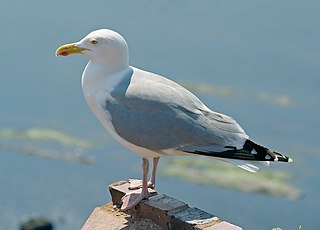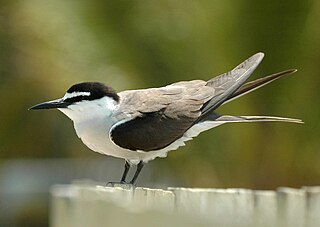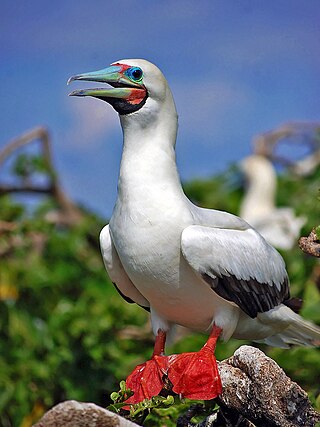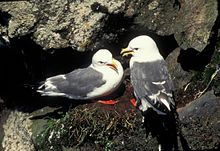
The kittiwakes are two closely related seabird species in the gull family Laridae, the black-legged kittiwake and the red-legged kittiwake. The epithets "black-legged" and "red-legged" are used to distinguish the two species in North America, but in Europe, where Rissa brevirostris is not found, the black-legged kittiwake is often known simply as kittiwake, or more colloquially in some areas as tickleass or tickleace. The name is derived from its call, a shrill 'kittee-wa-aaake, kitte-wa-aaake'. The genus name Rissa is from the Icelandic name Rita for the black-legged kittiwake.

The long-tailed skua or long-tailed jaeger is a seabird in the skua family Stercorariidae.

The European herring gull is a large gull, up to 66 cm (26 in) long. Common in coastal regions of Western Europe, it was historically more abundant. It breeds across Northern Europe, Western Europe, Central Europe, Eastern Europe, Scandinavia, and the Baltic states. Some European herring gulls, especially those resident in colder areas, migrate further south in winter, but many are permanent residents, such as in Ireland, Britain, Iceland, or on the North Sea shores. They have a varied diet, including fish, crustaceans, as well as some plants, and are also scavengers, consuming carrion and food left by or stolen from humans.

The lesser black-backed gull is a large gull that breeds on the Atlantic coasts of Europe. It is migratory, wintering from the British Isles south to West Africa. It has increased dramatically in North America, most common along the east coast. Formerly just a winter visitor, many birds are now spotted year-round. Some winters they occur in large numbers. Even on the west coast, this species has become an annual winter visitor in California with birds reported around most of the state each winter. They've even been seen in numbers at the Salton Sea. There is now serious concern about declines in many parts of the species range. The species is now on the RSPB Amber List because the UK is home to 40 per cent of the European population and more than half of these are found at fewer than ten sites.

The black guillemot or tystie is a medium-sized seabird of the Alcidae family, native throughout northern Atlantic coasts and eastern North American coasts. It is resident in much of its range, but large populations from the high arctic migrate southwards in winter. The bird can be seen in and around its breeding habitat of rocky shores, cliffs and islands in single or smalls groups of pairs. They feed mainly by diving towards the sea floor feeding on fish, crustaceans or other benthic invertebrates. They are listed on the IUCN red list as a species of least concern.

The glaucous gull is a large gull, the second-largest gull in the world. It breeds in Arctic regions of the Northern Hemisphere and winters south to shores of the Holarctic. The genus name is from Latin larus, which appears to have referred to a gull or other large seabird. The specific name hyperboreus is Latin for "northern" from the Ancient Greek Huperboreoi people from the far north "Glaucous" is from Latin glaucus and denotes the grey colour of the gull. An older English name for this species is burgomaster.

Pallas's gull, also known as the great black-headed gull, is a large bird species. As is the case with many gulls, it has traditionally been placed in the genus Larus. The scientific name is from Ancient Greek. Ichthyaetus is from ikhthus, "fish", and aetos, "eagle".

The yellow-legged gull is a large gull found in Europe, the Middle East and North Africa, which has only recently achieved wide recognition as a distinct species. It was formerly treated as a subspecies of either the Caspian gull L. cachinnans, or more broadly as a subspecies of the herring gull L. argentatus. The genus name is from Latin Larus which appears to have referred to a gull or other large seabird, and the species name honours the German zoologist Karl Michahelles.

The Caspian gull is a large gull and a member of the herring and lesser black-backed gull complex. The scientific name is from Latin. Larus appears to have referred to a gull or other large seabird, and cachinnans means 'laughing', from cachinnare 'to laugh'.

The ivory gull is a small gull, the only species in the genus Pagophila. It breeds in the high Arctic and has a circumpolar distribution through Greenland, northernmost North America, and Eurasia.

The bridled tern is a seabird of the family Laridae. It is a bird of the tropical oceans. The scientific name is from Ancient Greek. The genus comes from onux meaning "claw" or "nail", and prion, meaning "saw". The specific anaethetus means "senseless, stupid".

The Aleutian tern is a migratory bird living in the subarctic region of the globe most of the year. It is frequently associated with the Arctic tern, which it closely resembles. While both species have a black cap, the Aleutian tern may be distinguished by its white forehead. During breeding season, the Arctic terns have bright red bills, feet, and legs while those of the Aleutian terns are black.

The black-legged kittiwake is a seabird species in the gull family Laridae.

The kelp gull, also known as the Dominican gull, is a gull that breeds on coasts and islands through much of the Southern Hemisphere. The nominate L. d. dominicanus is the subspecies found around South America, parts of Australia, and New Zealand. L. d. vetula is a subspecies occurring around Southern Africa.

Cassin's auklet is a small, chunky seabird that ranges widely in the North Pacific. It is the only species placed in the genus Ptychoramphus. It nests in small burrows and because of its presence on well studied islands in British Columbia and off California it is one of the better known auks. It is named for the American ornithologist John Cassin.

The red-footed booby is a large seabird of the booby family, Sulidae. Adults always have red feet, but the colour of the plumage varies. They are powerful and agile fliers, but they are clumsy in takeoffs and landings. They are found widely in the tropics, and breed colonially in coastal regions, especially islands. The species faces few natural or man-made threats, although its population is declining; it is considered to be a least-concern species by the International Union for Conservation of Nature (IUCN).

The yellow-footed gull is a large gull, closely related to the western gull and thought to be a subspecies until the 1960s. It is endemic to the Gulf of California.

The glaucous-winged gull is a large, white-headed gull. The genus name is from Latin Larus which appears to have referred to a gull or other large seabird. The specific glaucescens is Neo-Latin for "glaucous" from the Ancient Greek, glaukos, denoting the grey color of its wings.

The swallow-tailed gull is an equatorial seabird in the gull family, Laridae. It is the only species in the genus Creagrus, which derives from the Latin Creagra and the Greek kreourgos which means butcher, also from kreas, meat; according to Jobling it would mean "hook for meat" referring to the hooked bill of this species. It was first described by French naturalist and surgeon Adolphe-Simon Neboux in 1846. Its scientific name is originally derived from the Greek word for gull, "Glaros" and via Latin Larus, "gull" and furca "two-tined fork". It spends most of its life flying and hunting over the open ocean. The main breeding location is in the Galápagos Islands, particularly the rocky shores and cliffs of Hood, Tower and Wolf Islands, with lower numbers on most of the other islands. It is more common on the eastern islands where the water is warmer.

The red-legged cormorant, also known as the red-legged shag, red-footed cormorant, red-footed shag, Gaimard's cormorant and grey cormorant, is a species of cormorant resident to the coastline of South America. It is the only member of the genus Poikilocarbo. It is non-colonial unlike most seabirds. The red-legged cormorant has not been observed wing-spreading, which is unusual among cormorant species.




























